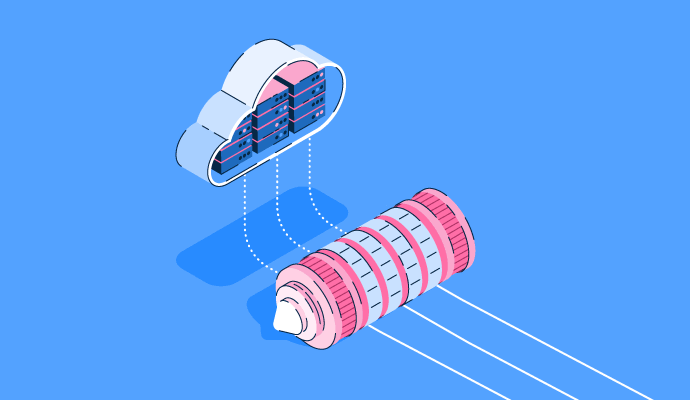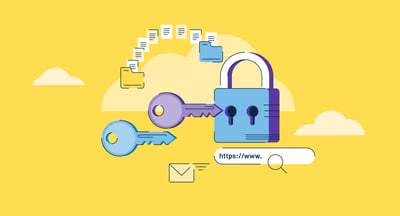May 31, 2023
 by Samudyata Bhat / May 31, 2023
by Samudyata Bhat / May 31, 2023

Data security and protection are the secrets to success for many businesses, and cloud data security providers are constantly evolving to offer the most advanced features.
Protecting your private data for business purposes is non-negotiable, but you can’t take for granted securing your sensitive information from anyone trying to gain illegal access. This can cause significant problems for any person or organization that depends on cloud services.
With so many potential cybersecurity hazards, knowing that your cloud data is secure allows you to focus on other elements of your business. This is where cloud encryption comes into play.
Cloud encryption is the process of converting data from plain text to an unreadable format, such as ciphertext, before transferring and storing it on the cloud.
Like any other type of data encryption, cloud encryption renders plain text data into an indecipherable format that can only be accessed with encryption keys, prohibiting unauthorized users from engaging with it. This holds even if the data is misplaced, stolen, or shared with an unwarranted user.
Encryption is often recognized as one of the most effective components of a company's cybersecurity strategy. Cloud encryption safeguards data from misuse and solves additional critical security challenges. These include:
Cloud storage companies provide their users with cloud storage encryption as a service. Customers who use cloud apps and infrastructure may also choose to add additional encryption protection. Whatever the case, an encryption platform converts the customer's data (which exists as plain text) into what is known as ciphertext.
Ciphertext cannot be read unless turned back into plain text using an encryption key. Then an algorithm transforms the encoded text back into its original form.
A cloud encryption platform can disguise data delivered to or from a cloud-based application, storage, or authorized remote system. The encrypted data is subsequently stored on cloud servers, where unauthorized users or bots are prohibited from viewing the data or files.
Only authorized personnel with the encryption key may read the material in its original form. When a user logs in using their authentication and access methods, many of the big cloud storage providers handle all of the cloud storage encryption procedures (encryption, key exchange, and decryption) in the background.
An enterprise must pick the degree and kind of encryption to utilize with a cloud provider. The three primary forms of cloud data encryption are discussed below.
This type refers to data encryption after storing it, guaranteeing that an attacker with physical infrastructure or hardware cannot read the data or files. Encryption can occur on the cloud provider's (server's) side, the client's side, at the disk or file level, or any mix of the three.
Server-side encryption is cloud storage encryption that occurs after the cloud service receives the data, but before it’s stored. This is an option provided by the majority of cloud providers.
Before data is transferred to a cloud application or storage, it’s encrypted on the client side. The company or customer is in charge of encrypting and decrypting the data and controlling encryption keys. Although some cloud storage providers may offer this as a service. Client-side encryption allows businesses to safeguard their most sensitive data, lowering expenses. Many businesses use client-side encryption in addition to server-side encryption.
And finally, file-based encryption (FBE) is a type of storage encryption in which the system encrypts individual files or directories.
The HTTPS protocol, which adds a security sockets layer (SSL) to the regular IP protocol, automatically encrypts a major percentage of data in transit. SSL encrypts all activity, guaranteeing only authorized users can access session information. As a result, if an unauthorized user intercepts data sent during the session, the information is worthless. A digital key is used to finish decoding at the user level.
This new form of encryption is intended to safeguard data while it’s being used. While not frequently implemented, technologies like "confidential computing,” which provides real-time encryption at the computer chip level, and "homomorphic encryption,” which uses an encryption algorithm that only enables specific types of processing on the data, are being explored.
Encryption algorithms are a set of rules that an encryption process follows. It includes key length, features, and functionalities that ensure effective encryption. Symmetric and asymmetric encryption are the two main encryption algorithms for cloud-based data
Every credible cloud service provider (CSP) provides basic security, such as encryption. Still, cloud users should take further precautions to maintain data security.
Cloud security frequently adheres to the "shared responsibility model.’ This implies that the cloud provider must monitor and respond to security risks relating to the underlying infrastructure of the cloud. At the same time, end users, including individuals and businesses, are responsible for safeguarding the data and other assets stored in their cloud environments.
Organizations that employ a cloud-based model or are transitioning to the cloud must establish and implement a comprehensive data security plan specially tailored to safeguard and defend cloud-based assets. Encryption is a critical component of any efficient cybersecurity plan. Other elements include:
Encryption is one of the most significant security measures businesses use to protect their data, intellectual property (IP), and other sensitive information, as well as their customers' data. It also addresses privacy and security norms and legislation.
The following are some of the many benefits of cloud encryption.
Cloud encryption is a simple and effective security method. Unfortunately, many firms miss this component of their cybersecurity strategy, most likely because they don’t know about or don’t get the concept of the public cloud's shared responsibility paradigm.
Additional challenges may include the following.
If your firm has previously utilized encryption, cloud encryption services will likely be fairly similar. Enterprises must exercise caution to ensure the cloud encryption delivered fulfills their security requirements.
Below are some best practices to consider when investigating and deploying cloud encryption.
Invest in good cloud file storage services because the cloud provider is also responsible for cloud storage security and encryption.
Businesses use cloud data security technologies to secure information stored using cloud services or within cloud-based applications. Pick the right platform based on what works for your company.
The following are some of the best cloud data security software tools that facilitate data security by enforcing cloud access control and storage policies.
*Above are the five leading cloud data security solutions from G2’s Spring 2023 Grid® Report.
Numerous ransomware incidents and data breaches have emphasized the need for reliable encrypted storage and backup strategy. Therefore, businesses are leaning on cloud technology to protect themselves against financial and public relations losses.
Cloud solutions with durability and stratospheric costs will drive more businesses and organizations to shift their data to the cloud.
There was a time when filing meant stacking boxes of paperwork everywhere in the workplace. The idea of storage and data protection is now entirely online, making storing, sharing, and securing data easier than ever.
Discover more on how you can keep your cloud data safe!
Samudyata Bhat is a Content Marketing Specialist at G2. With a Master's degree in digital marketing, she currently specializes her content around SaaS, hybrid cloud, network management, and IT infrastructure. She aspires to connect with present-day trends through data-driven analysis and experimentation and create effective and meaningful content. In her spare time, she can be found exploring unique cafes and trying different types of coffee.
Data needs security, and security needs encryption.
 by Sagar Joshi
by Sagar Joshi
In today’s vast digitally-connected world, it can be difficult to maintain some privacy.
 by Devin Pickell
by Devin Pickell
If your organization stores sensitive or personally identifiable data, such as financial...
 by Alyssa Towns
by Alyssa Towns
Data needs security, and security needs encryption.
 by Sagar Joshi
by Sagar Joshi
In today’s vast digitally-connected world, it can be difficult to maintain some privacy.
 by Devin Pickell
by Devin Pickell


